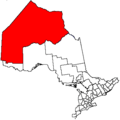Lac Seul First Nation
| Lac Seul 28 Obishikokaang | |
|---|---|
| Indian reserve | |
| Lac Seul Indian Reserve No. 28 | |
 Lac Seul 28 | |
| Coordinates: 50°15′N 92°13′W / 50.250°N 92.217°WCoordinates: 50°15′N 92°13′W / 50.250°N 92.217°W | |
| Country |
|
| Province |
|
| District | Kenora |
| First Nation | Lac Seul |
| Area[1] | |
| • Land | 239.09 km2 (92.31 sq mi) |
| Population (2011)[1] | |
| • Total | 872 |
| • Density | 3.6/km2 (9/sq mi) |
| Website | lacseul.firstnation.ca |
Lac Seul First Nation is an Ojibwe First Nation band government located on the southeastern shores of Lac Seul, 56 kilometres (35 mi) northeast of the city of Dryden, Ontario. Though Lac Seul First Nation is a treaty signatory to Treaty 3, the First Nation is a member of the Independent First Nations Alliance, a regional tribal council and a member of the Nishnawbe Aski Nation.
The registered population of Lac Seul was 2,837 persons in April 2008, of which the on-reserve population was 774. The First Nation have the 26,821.5 hectares (104 sq mi) Lac Seul 28 Indian Reserve, known as Obishikokaang in the Anishinaabe language, containing three settlements. Frenchmen's Head is accessible by road and is approximately 40 kilometres (25 mi) from Sioux Lookout. Whitefish Bay is also newly accessible by road and is approximately 50 kilometres (31 mi) from Sioux Lookout, Ontario. Kejick Bay is approximately 60 kilometres (37 mi) northwest of Sioux Lookout and is accessible by road and water and air. Frenchmen's Head and Kejick Bay each have a population of about 400 each, while Whitefish Bay has a population of about 100.
In 1929 Ontario Hydro constructed a dam at Ear Falls to control the level of the lake to produce hydroelectricity. The flooding from turning the lake into a reservoir caused the area known previously as Kejick Bay to become an island, permanently separating it from the mainland and splitting the community into two parts. The island portion retained the name Kejick Bay and the portion of the community on the mainland became Whitefish Bay.
The Indian reserve is bordered on all sides by territory of the Unorganized Kenora District, except at its southeast, which borders the town of Sioux Lookout.
Name
The French name for the lake and the reserve, Lac Seul, may be a mistranslation of Obishikokaang as Obezhigokaang. The meaning of Obishikokaang is not known but the typical translation of Obishikokaang provided is "Narrows [Abundant] with White Pine" or "White Pine Narrows", which in common Ojibwe should be something closer to Obaazhingokaang.
Governance
The First Nation is governed by Chief Clifford Bull and eight councillors: Elvis Trout, Floyd Vincent, Raymond Angeconeb, Samantha Kejick, Derek Maud, Gerald Kejick, Stan Littledeer, and Wade Bull. Of the councillors, four are from Frenchman's Head, three are from Kejick Bay and one from Whitefish Bay.
Settlements
- Canoe River, Ontario—a historical settlement, which its residents were relocated to Kejick Bay
- Frenchmen's Head, Ontario (Wemitigoozhiiwitigwaaning)
- Kejick Bay, Ontario
- Whitefish Bay, Ontario
- Hudson, Kenora District—a nearby town with many residents registered with Lac Seul First Nation
External links
References
- 1 2 "Lac Seul 28 census profile". 2011 Census of Population. Statistics Canada. Retrieved 29 May 2015.
 |
Lac Seul | |
Unorganized Kenora |  |
| |
||||
| ||||
| | ||||
| Unorganized Kenora | |
Sioux Lookout |
